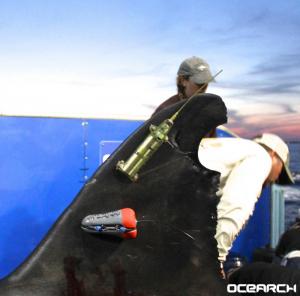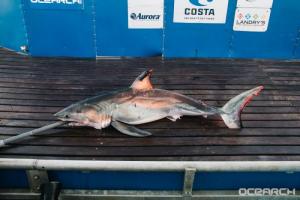Shark attacks, injuries rare in Delaware
Two great white sharks dominated headlines over the Memorial Day weekend as they swam along the mouth of Delaware Bay.
But those worried about being bitten by a shark while swimming in Delaware waters should rest easy knowing they’re about 45,000 times more likely to be injured in a car accident than by a shark attack.
“People need to know how to swim because they're more likely to drown than have an interaction with a shark,” said Chris Fischer, founding chairman and expedition leader of OCEARCH, an international research organization that tracks sharks. “If you're afraid of sharks, immediately get rid of your dog, never cross the street or get in an automobile. The fear of sharks is an irrational fear that doesn't statistically exist.”
For millions of years, large shark species have traveled along the East Coast. This is just the first time scientists have been able to pinpoint exactly where they are, providing data for future scientific papers while also engaging and educating the public.
“These white sharks, like Cisco and Mary Lee, have always been coming into the Delaware Bay,” Fischer said. Cisco and Mary Lee are two of more than 300 sharks tagged by OCEARCH since the organization's research efforts began in 2007. Cisco, an 8-foot-7-inch immature male great white weighing about 360 pounds, broke the water's surface at the mouth of the Delaware Bay in the early morning hours of May 26, alerting scientists and everyone who follows OCEARCH's international shark tracker of his exact location.
Two days later, Mary Lee, a 16-foot, mature female great white weighing more than 3,400 pounds, pinged – that's the term used when the tracker is able to transmit a signal to a satellite – just short of the mouth of the Delaware Bay.
“That was fun, but now I really must be on my way. Later, @Shark_Cisco -;(),” read a tweet from @MaryLeeShark's Twitter account as she pinged farther offshore May 29.
Fischer said OCEARCH wants to involve the public in its research to change a historically negative public perception of sharks.
“We're not only developing science for policy,” he said. “We're engaging with the public in one of the most charismatic research projects in history. By being inclusive and open sourcing and letting everyone in in real time, we've shifted that tone.”
An irrational fear of shark attacks is one reason why local lifeguards, even if they see an ominous fin breaking the water's surface, will never use the word “shark” when alerting Delaware beachgoers it might not be safe to swim.
- Always swim near a guarded beach
- Always check in with the lifeguard on duty for any possible hazards
- Avoid swimming in large schools of fish
- Avoid swimming where people are fishing
- Avoid swimming near any type of bait
- Avoid swimming at dusk, dawn or night
- Avoid wearing jewelry or anything that might flash in the water
- If you see a shark, keep your distance and get out of the water
SOURCE: Todd Fritchman, Dewey Beach Patrol
Click Here for Interactive Graphic

“We have an elaborate training process and protocols for 'marine activity,'” said Dewey Beach Patrol Captain Todd Fritchman. “We never mention the word shark because that immediately stimulates a mass hysteria on the beach.
“I've been doing this 36 years and in the old days, we'd say there's a shark. But now, someone turns around and says shark, then it goes down the line until everyone is screaming, 'shark.'”
In more than three decades of protecting beachgoers in Rehoboth and Dewey beaches, Fritchman said he can only recall one mild bite to an ankle. The last reported shark-related injury in Delaware was in June 2014, when a 16-year-old from Delmar had to get 23 stitches in his forearm when a shark bit him while he was swimming in the shallows of Cape Henlopen State Park. State officials said it was likely the teen was bitten by a juvenile sandbar shark as it fed at prime time - around 5 p.m.
That marked the fourth confirmed unprovoked shark bite reported on the Delaware coast since recordkeeping began in 1837, none of which were fatal, said George Burgess, director of the Florida Museum of Natural History's International Shark Attack File.
“Your chances of going to the beach and dying of a shark attack in Delaware are about zero,” Burgess said, attributing the low risk to Delaware's small coastline, short swimming season and native shark species.
Fritchman agreed Delaware is pretty safe when it comes to shark-related injuries.
“Marine fish species, including sharks and rays, are not looking to seek a meal from a human being,” he said. “Sharks are all around us all the time; you just can't see them.”
Fischer said sharks near Delaware also are more skittish and likely to swim away because cage diving, which has conditioned some sharks in other parts of the world, is not common in the area.
“They're truly wild,” he said. “These animals are so nervous, so afraid of humans and noises, they bug out.”
In the five years since Mary Lee was tagged, not one person has actually seen her, Fischer said.
“She doesn't want to be seen,” he said. But large sharks like Mary Lee don't necessarily stick to deep waters. They follow the food.
“We've tagged 17-foot white sharks in 12 feet of water,” Fischer said. “Mary Lee doesn't mind coming into rivers and bays and estuaries and the beach where life is.”
Having sharks like Mary Lee and Cisco - and all the others that aren't tagged and tracked - is actually quite good news for Delaware, Fischer said.
“It's a great sign for the Delaware Bay that these large apex predators are moving through - it means the system is in pretty good shape,” he said. “It's a great sign they're moving through your area because there's abundant life. They're balancing the system, taking out the weak and the sick. They are the balance keepers.”











.jpg)














































